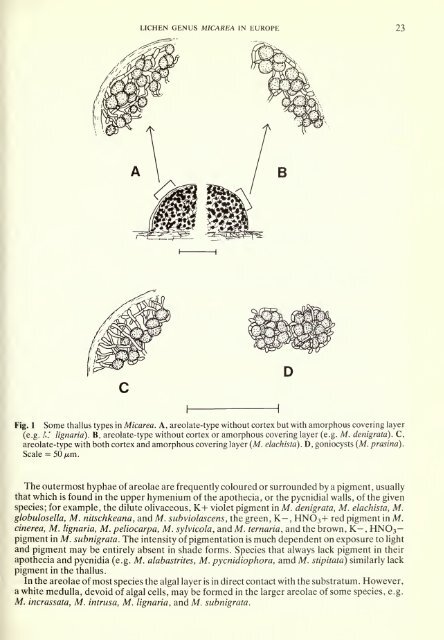Bulletin of the British Museum (Natural History)
Bulletin of the British Museum (Natural History)
Bulletin of the British Museum (Natural History)
You also want an ePaper? Increase the reach of your titles
YUMPU automatically turns print PDFs into web optimized ePapers that Google loves.
LICHEN GENUS MICAREA IN EUROPE 23<br />
Fig. 1 Some thallus types in Micarea. A, areolate-type without cortex but with amorphous covering layer<br />
(e.g. LI lignaria). B, areolate-type without cortex or amorphous covering layer (e.g. M. denigrata). C,<br />
areolate-type with both cortex and amorphous covering layer (M. elachista). D, goniocysts (A/, prasina).<br />
Scale = 50 /Ltm.<br />
The outermost hyphae <strong>of</strong> areolae are frequently coloured or surrounded by a pigment , usually<br />
that which is found in <strong>the</strong> upper hymenium <strong>of</strong> <strong>the</strong> apo<strong>the</strong>cia, or <strong>the</strong> pycnidial walls, <strong>of</strong> <strong>the</strong> given<br />
species; for example, <strong>the</strong> dilute olivaceous, K+ violet pigment in M. denigrata, M. elachista, M.<br />
globulosella, M. nitschkeana, and M. subviolascens, <strong>the</strong> green, K— , HNO3+ red pigment in M.<br />
cinerea, M. lignaria, M. peliocarpa, M. sylvicola, and M. ternaria, and <strong>the</strong> brown, K- , HNO3—<br />
pigment in M. subnigrata. The intensity <strong>of</strong> pigmentation is much dependent on exposure to light<br />
and pigment may be entirely absent in shade forms. Species that always lack pigment in <strong>the</strong>ir<br />
apo<strong>the</strong>cia and pycnidia (e.g. M. alabastrites, M. pycnidiophora, amd M. stipitata) similarly lack<br />
pigment in <strong>the</strong> thallus.<br />
In <strong>the</strong> areolae <strong>of</strong> most species <strong>the</strong> algal layer is in direct contact with <strong>the</strong> substratum. However,<br />
a white medulla, devoid <strong>of</strong> algal cells, may be formed in <strong>the</strong> larger areolae <strong>of</strong> some species, e.g.<br />
M. incrassata, M. intrusa, M. lignaria, and M. subnigrata.

















